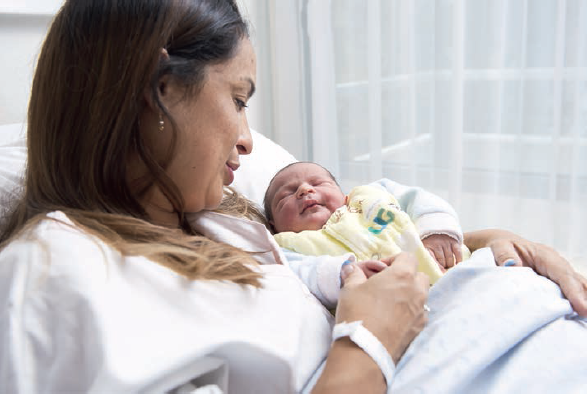 When to leave for the Maternity ?
When to leave for the Maternity ?- Your admission
- The delivery rooms
- Pain during labor
- Epidural
- Delivery complications
- After giving birth
At the Maternity, a team of healthcare professionals (midwives, gynaecologists, obstetricians, anaesthetists, paediatricians, nursing auxiliaries) are available 24/7.
When to leave for the Maternity ?
The following signs indicate the delivery is imminent and that you must now go to the Maternity.
- contractions are increasingly frequent, close together and regular
- contractions are increasingly painful
- your waters have broken.
Your admission
An admissions team, located at the main entrance, helps you register Mondays to Fridays 7.30 am to 5 pm. Outside of these hours, Reception is available until 8 pm. If labor has already started, admission
is conducted at the Gynaecology and Obstetrics Emergency Services (24/7).
When you arrive, you are attended to by a midwife who will assist at every stage of the birth. As soon as you arrive, she monitors the uterine contractions and assesses the well-being of your baby by recording his/her heart rate.
INFO
All bedrooms have locked wardrobes. Avoid bringing significant amounts of money and valuables. The HUG assumes no responsibility in the event of theft or loss.
Mobile phones
To avoid disturbing other patients and the care being provided, please turn your mobile phone off in the delivery room, the continuous care and prenatal rooms. Its use is tolerated in other areas but remain discrete.
The delivery rooms
The Maternity has twelve delivery rooms, two of which are “natural” rooms. All the rooms are equipped with a bed, a private shower, a locked wardrobe and a changing table to provide initial care for your baby.
In addition to the standard bed, the “natural” rooms have a parental bed allowing for natural delivery (without anesthesia) and on which you can move as you wish. It can also be used to rest after the birth. A bath is also available for you to relax during the early stages of labor or the dilation stage, but not for the entire delivery.
One person of your choice (partner, family member or friend) is allowed to attend. When you are admitted, this person receives a badge allowing him/her to freely access the service.
Pain during labor
Pain during labor is what pregnant women fear most as the term approaches. Rest assured that in addition to support and attention, the Maternity has various methods to help you manage pain throughout the delivery such as massages, pre-labor baths, positions, use of nitrogen oxide (or “laughing gas”), etc. And of course, the epidural which is chosen by most women and is the most effective method.
INFO
The anesthesiology team is available 24/7. Over 80% of women giving birth at the Maternity choose the epidural.
Epidural
An epidural minimises pain during delivery. This anesthesia acts locally and the product can be dosed during labor. In addition to being a safe and well-controlled technique, it preserves the perception
of contractions, the pushing reflex and, in certain cases, your mobility. It is without danger for the baby and complications are rare. In the event of contraindications, alternatives are proposed.
You can choose to have an epidural (rachi-epidural or simple epidural). It is sometimes chosen for medical reasons.
To find out more :
The Division of Anesthesiology organises a class on the epidural that you should attend before week 38 of your pregnancy.
Delivery complications
In most cases, childbirth via vaginal delivery runs smoothly. Certain situations require the use of instruments (forceps, vacuum extractor) or an emergency caesarean section to deliver the baby
or prevent maternal or fetal distress. Caesarean sections may also be programmed in certain maternal or fetal indications.
Despite a high proportion of high-risk pregnancies, the Maternity’s caesarean section rate is low compared to the Swiss average. It was 28% in 2015 whereas the national average was 33%. A class in “giving birth differently” is organised for women for whom a caesarean section has been planned.
